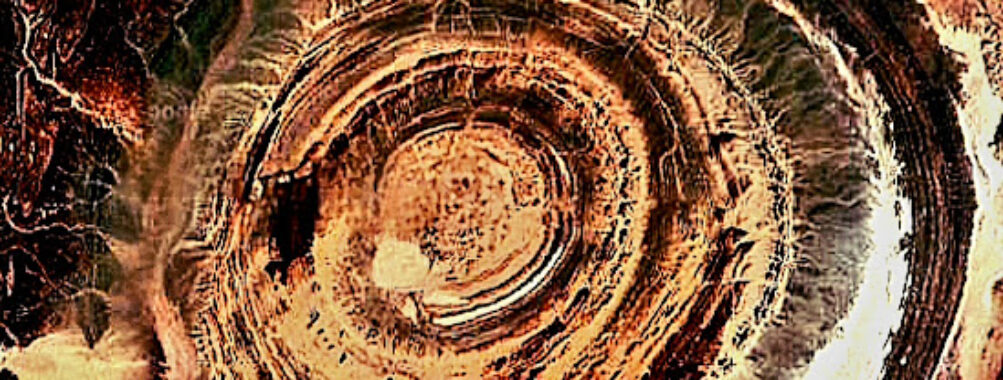
Richat Structure
Table of Contents
Description
Looking at the Earth from space, you’ll spot an extraordinary circular formation in the heart of Mauritania’s Sahara Desert that’ll make you do a double-take. The Richat Structure, also known as the Eye of the Sahara, is one of our planet’s most fascinating geological mysteries. This massive bulls-eye pattern spans roughly 25 miles across and honestly, it’s the kind of sight that’ll make your jaw drop.
I remember the first time I saw aerial photos of this remarkable formation – it genuinely looks like someone dropped a giant stone into the desert sand, creating perfect concentric rings. But here’s the thing: while scientists initially thought it was an impact crater from a meteorite, they’ve since discovered it’s actually an eroded geological dome that’s been around for hundreds of millions of years.
The structure’s alternating bands of exposed rock create an otherworldly appearance that’s absolutely mesmerizing. Ancient rocks, exposed through millions of years of erosion, form rings of different colors and textures. And ya know what’s really cool? Some folks even theorized it might be the lost city of Atlantis due to its remarkable similarity to Plato’s descriptions – though that’s more in the realm of fascinating speculation than scientific fact.
Key Features
- Massive circular structure spanning approximately 25 miles in diameter
- Distinctive concentric rings visible from space
- Ancient geological layers exposed through natural erosion
- Unique rock formations including breccia, quartzite, and various sedimentary rocks
- Natural desert environment with remarkable photographic opportunities
- Historical significance in geological studies
- Spectacular aerial viewing possibilities
- Rich mineral deposits throughout the structure
Best Time to Visit
Trust me on this one – timing your visit to the Richat Structure is crucial. The best months are between November and February, when the Sahara’s brutal heat takes a bit of a break. During these months, temperatures hover around a more manageable 75-85°F (24-29°C), making exploration actually enjoyable rather than an endurance test.
Avoid visiting during summer months (June through September) when temperatures can soar above 115°F (46°C). And lemme tell you, there’s basically zero shade out there in the middle of the desert. Early morning or late afternoon visits offer the best lighting for photography – the low sun angle really brings out those amazing textures and colors in the rock formations.
How to Get There
Getting to the Eye of the Sahara isn’t exactly a walk in the park – but that’s part of the adventure! Your best bet is to fly into Nouakchott, Mauritania’s capital city. From there, you’ll need to arrange either a 4×4 vehicle or join an organized tour heading to Ouadane, the nearest town to the structure.
The journey from Nouakchott takes about 3 days, crossing through some pretty intense desert terrain. Seriously, don’t even think about attempting this trip without an experienced guide – the Sahara isn’t the place to test your navigation skills. Most visitors opt for organized tours that handle all the logistics, including camping equipment and supplies.
Tips for Visiting
Alright, here’s the real deal about visiting this incredible place. First off, you absolutely MUST bring way more water than you think you’ll need – I’m talking at least 4-5 liters per person per day. The desert is no joke, y’all.
Pack some serious sun protection – we’re talking high SPF sunscreen, a wide-brimmed hat, and loose-fitting, light-colored clothing that covers your skin. Sunglasses are non-negotiable – the glare out here can be intense. And don’t forget some sturdy hiking boots with good ankle support – the terrain is pretty rough.
Photography enthusiasts should bring their wide-angle lenses – trust me, you’ll want them for capturing the structure’s massive scale. But here’s a pro tip: bring a good quality zoom lens too, because some of the most interesting details are in the rock formations themselves.
Consider hiring a local guide who knows the area well. They can share fascinating insights about the geology and help you find the best viewpoints. Plus, they know all the safety protocols for desert travel, which is crucial out here.
And lemme be real with you – cell service is pretty much non-existent out here, so download offline maps and bring a satellite phone if possible. It’s also smart to inform someone of your travel plans before heading out into the desert.
Finally, pack some basic first aid supplies and any medications you might need. The nearest medical facilities are pretty far away, so it’s better to be prepared. And don’t forget to respect this incredible natural wonder – take nothing but pictures, leave nothing but footprints, ya know what I mean?
Location
Places to Stay Near Richat Structure
Find and Book a Tour
Explore More Travel Guides
No reviews found! Be the first to review!